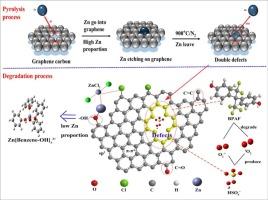Construction of ordered pores and defects in catalyst's carbon skeleton by a “doping-volatilization” template strategy
IF 6.3
2区 工程技术
Q1 ENGINEERING, CHEMICAL
引用次数: 0
Abstract
ZnCl2 is used as a pore-forming agent to increase the specific surface area of carbon materials. However, traditional acid washing methods inevitably damage the surface structure of biochar. Herein, a “doping-volatilization” method of ZnCl2 was designed. The ZnCl2 modified Lycium barbarum biochar were investigated on their structure-function relationship. Significant differences were observed in the performance of various ratios of ZnCl2-modified biochar in the degradation of bisphenol AF by activated peroxymonosulfate (PMS). The defective structure served as the main active site, and the oxidation of bisphenol AF was dominated by the oxidation of singlet oxygen (1O2). Meanwhile, it was found that the etching and pore-forming performance of ZnCl2 on biochar change with the increase in proportion. Therefore, reasonable control of the addition ratio of ZnCl2 can effectively control its effect and provide a reference for the application of biochar in wastewater treatment.

通过 "掺杂-挥发 "模板策略在催化剂碳骨架中构建有序孔隙和缺陷
ZnCl2 可用作孔隙形成剂,以增加碳材料的比表面积。然而,传统的酸洗方法不可避免地会破坏生物炭的表面结构。在此,我们设计了一种 ZnCl2 的 "掺杂-挥发 "方法。研究了 ZnCl2 改性枸杞生物炭的结构-功能关系。在活化过一硫酸盐(PMS)降解双酚 AF 的过程中,不同比例的 ZnCl2 改性生物炭的性能存在显著差异。缺陷结构是主要的活性位点,双酚 AF 的氧化主要是单线态氧(1O2)的氧化。同时,研究还发现 ZnCl2 在生物炭上的蚀刻和成孔性能随添加比例的增加而变化。因此,合理控制氯化锌的添加比例可有效控制其效果,为生物炭在废水处理中的应用提供参考。
本文章由计算机程序翻译,如有差异,请以英文原文为准。
求助全文
约1分钟内获得全文
求助全文
来源期刊

Journal of water process engineering
Biochemistry, Genetics and Molecular Biology-Biotechnology
CiteScore
10.70
自引率
8.60%
发文量
846
审稿时长
24 days
期刊介绍:
The Journal of Water Process Engineering aims to publish refereed, high-quality research papers with significant novelty and impact in all areas of the engineering of water and wastewater processing . Papers on advanced and novel treatment processes and technologies are particularly welcome. The Journal considers papers in areas such as nanotechnology and biotechnology applications in water, novel oxidation and separation processes, membrane processes (except those for desalination) , catalytic processes for the removal of water contaminants, sustainable processes, water reuse and recycling, water use and wastewater minimization, integrated/hybrid technology, process modeling of water treatment and novel treatment processes. Submissions on the subject of adsorbents, including standard measurements of adsorption kinetics and equilibrium will only be considered if there is a genuine case for novelty and contribution, for example highly novel, sustainable adsorbents and their use: papers on activated carbon-type materials derived from natural matter, or surfactant-modified clays and related minerals, would not fulfil this criterion. The Journal particularly welcomes contributions involving environmentally, economically and socially sustainable technology for water treatment, including those which are energy-efficient, with minimal or no chemical consumption, and capable of water recycling and reuse that minimizes the direct disposal of wastewater to the aquatic environment. Papers that describe novel ideas for solving issues related to water quality and availability are also welcome, as are those that show the transfer of techniques from other disciplines. The Journal will consider papers dealing with processes for various water matrices including drinking water (except desalination), domestic, urban and industrial wastewaters, in addition to their residues. It is expected that the journal will be of particular relevance to chemical and process engineers working in the field. The Journal welcomes Full Text papers, Short Communications, State-of-the-Art Reviews and Letters to Editors and Case Studies
 求助内容:
求助内容: 应助结果提醒方式:
应助结果提醒方式:


